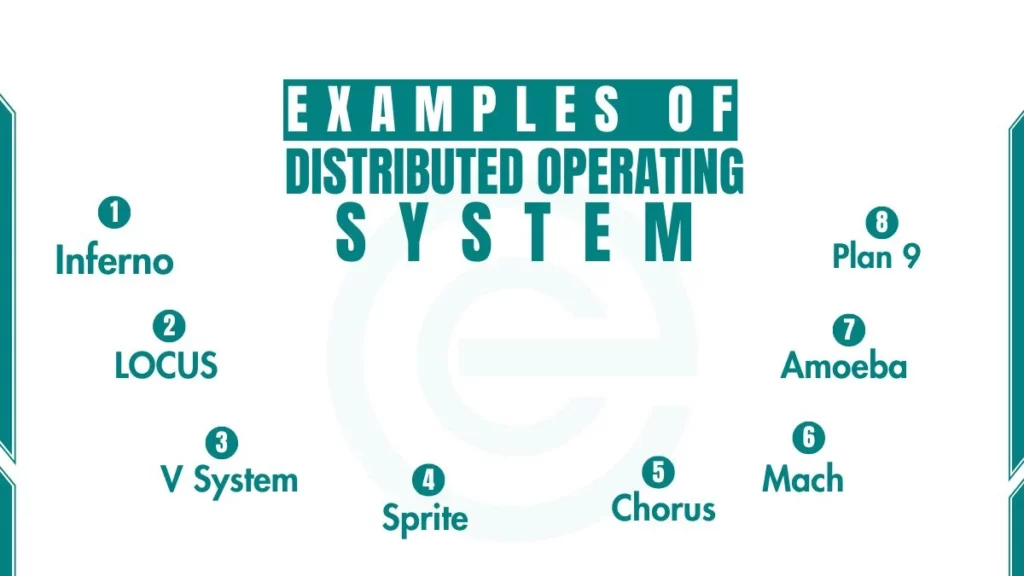A Distributed Operating System (DOS) manages a group of connected computers to make them work together as a single system. Examples of Distributed Operating Systems include Plan 9, Amoeba, Mach, GFS, V system, LOCUS, and many more which we look at below in this article.
Distributed Operating System Examples
The following are the distributed operating system examples in real life:

1. Plan 9 from Bell Labs
Plan 9 is a distributed operating system created by Bell Labs. It is designed to make all system resources look like files. This design simplifies the way users and programs interact with the system.
Plan 9 is used in research to study how distributed systems can be more efficient. It handles multiple users working together on different computers while sharing resources smoothly.
2. Amoeba
Amoeba is a distributed operating system developed in the late 1980s and early 1990s. It was designed to connect multiple computers into a single system. It uses a microkernel architecture, which means the system’s core is small and efficient.
Amoeba allows computers to share files, memory, and processing power. Researchers often use Amoeba to study advanced distributed computing methods. It also has a strong security system based on capabilities, which control access to resources.
3. Mach
Mach is a distributed system kernel created at Carnegie Mellon University. It acts as the foundation for building distributed applications. Its design focuses on flexibility and portability across different hardware platforms.
Mach separate the operating system into small parts, making it easier to manage and upgrade. It is also used in systems like macOS and NeXTSTEP, showing its influence in modern computing.
4. Chorus
Chorus is a distributed operating system developed in France. It is built for real-time systems, which require quick and predictable responses. Chorus uses a modular structure, which can be customized for specific tasks like telecommunications or embedded systems. Its design supports scalability, so it works well on both small devices and large networks.
5. Sprite
Sprite is a distributed operating system from the University of California, Berkeley. It is known for its ability to migrate processes. This means a running program can move from one computer to another without stopping.
Sprite provides a unified file system that looks the same to all users. No matter which computer they use. It is often studied for its innovative file management and process handling techniques.
6. V System
The V System distributed os developed at Stanford University. It is designed to make a network of computers act like one. It focuses on interprocess communication, which allows programs running on different computers to share data easily.
The V System also supports distributed processes, meaning tasks can be divided among multiple machines. This system is used in research to understand how to make distributed systems more efficient.
7. LOCUS
LOCUS is a distributed os that provides a single system image. This means users see all connected computers as one, making it easier to work across multiple machines. LOCUS supports process migration and transparent file access.
Researchers use LOCUS to study how to make distributed systems fault-tolerant, ensuring they keep working even if some parts fail.
8. Inferno
Inferno DOS was developed by Bell Labs. It is a distributed system for building applications that work on various devices. It uses a virtual machine called Dis. They allow it to run on different hardware platforms.
Inferno is lightweight and is often used in embedded systems like smart devices and network equipment. It simplifies programming for distributed environments by using a single programming language and system interface.
9. Microsoft Azure
Microsoft Azure is a cloud computing platform. It allows users to build and manage applications using a network of global data center. Azure provides tools for distributed computing, such as managing servers, databases, and virtual machines.
It supports a variety of programming languages and frameworks, making it versatile. Azure is widely used in businesses and industries for web applications, data storage, and artificial intelligence.
10. Google File System (GFS)
GFS is a distributed file system developed by Google. It is designed to store and manage massive amounts of data across many machines. GFS splits files into smaller pieces and spreads them across multiple servers.
This approach ensures high performance and reliability. GFS is the backbone of many Google services like Search, Maps, and YouTube.
